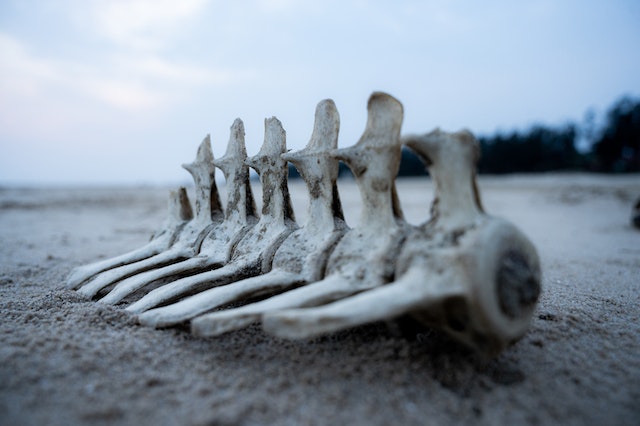
Are all bones made of calcium? Mammal bones and bird bones are all mostly made of collagen and calcium. Fish bones are either made of collagen and calcium, or of cartilage.
Our bones, and all mammal bones, are not made only of calcium. Calcium is a large part, but it is not everything. Mammal bones are made from a matrix of collagen fibers. Collagen is a structural protein that is the most abundant protein in mammals. Collagen is elastic and flexible. This collagen gives bones enough elasticity to stop them fracturing or shattering. The collagen is covered in calcium phosphate which binds to the fibers and gives bones their strength and rigidity. One of the materials without the other wouldn’t be any good for us. It is a combination of the two that give us bones hard and strong enough to support us, but flexible and elastic enough that they don’t shatter and can handle significant stress. Bones are incredibly strong and it can take up to 4,000 Newtons of force to break a bone.
Inside the bones, all mammals also have bone marrow. This is a soft tissue that makes red blood cells, white blood cells, and platelets. There is also a type of bone marrow called yellow marrow that has a lot of fat. Yellow marrow contains stem cells that become cartilage, fat, or bone cells. The bone marrow needs a blood supply and there are many blood vessels that run in and out of the bones. The ends of the bones have very large pores that the vessels run through.
Bird bones are made of a similar material to ours, but they have a very different structure. To begin with, bird bones are more dense than our bones. Mammals have very porous bones, but bird bones have fewer holes. Bird bones are also hollow because they don’t have the bone marrow that mammals do. This doesn’t mean that they are completely hollow, though. They have strands of collagen and calcium that cross over the hollow spaces, giving them support. This makes the bones very strong and very light. The bones obviously need to be light because birds fly. They also need to be strong because birds have to support all of their weight on their long wing bones.
An interesting property of bird bones is that they can fill the hollow spaces with air. Birds, especially birds that fly long distances, need more oxygen than many mammals. They have air sacs that link to the inside spaces of the bones and when they are high up, air is forced into the bones, giving them more air to breathe from and more oxygen to use.
There are two types of bones in fish. The first type are called cartilaginous because their bones are made of cartilage. Examples of these fish are sharks, skates, and rays. They have skeletons made of cartilage because it is softer, lighter, and more flexible than bone. Sharks are predators so they have to swim a long way to hunt for food. They need the light bones to save as much energy as they can. They also need to be able to turn quickly to chase fish, and their flexible cartilage skeleton allows them to do that. One difference between cartilaginous fish and bony fish is that fish with cartilage have gills that are just slits. Bony fish keep their gills open with a bone covering.
Other fish have bones that are similar in material to our own. They are a frame of collagen with calcium to stabilize them. The difference is that fish bones are much smaller and much thinner than mammal bones. The main reason for this is that our bones have to be load bearing, while fish bones are only really there to anchor the muscles to. Fish are supported by the water both inside and out, so they don’t need any real support from their skeleton.
The fact that most animals have the same type of bones shows that we all came from a common ancestor. The bones have evolved in different ways to suit the environments that the different animals live in, but they are mostly all a collagen and calcium structure. And this is what I learned today.
Sources
https://askabiologist.asu.edu/bone-anatomy
https://www.discovery.com/science/force-to-break-bone
https://en.wikipedia.org/wiki/Bone
https://www.bones.nih.gov/health-info/bone/bone-health/what-is-bone
https://askabiologist.asu.edu/human-bird-and-bat-bone-comparison
https://www.sciencedaily.com/releases/2010/03/100322112103.htm
https://www.pheasant.com/resources/avian-skeletal-system
https://birdfact.com/articles/do-birds-have-hollow-bones
https://byjus.com/biology/fish-skeletal-system/
https://nerdfighteria.info/v/U4b-Mv_3e4U/
https://www.thoughtco.com/what-is-a-cartilaginous-fish-2291875
